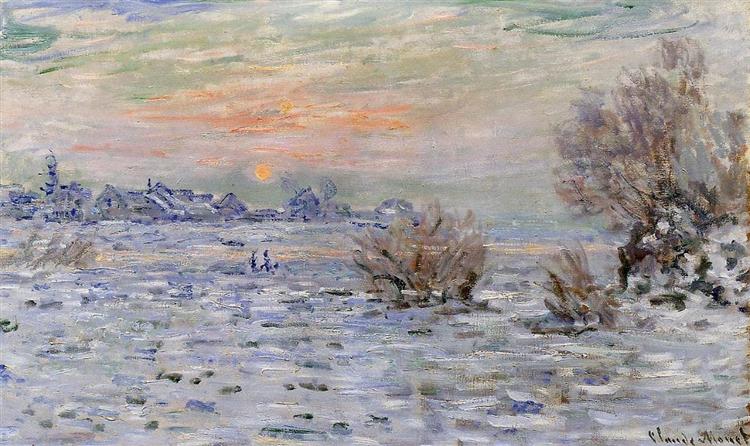Tanım
Claude Monet's Winter on the Seine - Lavacourt (1880) is a remarkable example of the painter's ability to capture the essence of a winter landscape while experimenting with light and color. Monet, one of the founders of the Impressionist movement, uses this painting to explore atmospheric variations and the effects of weather on the environment. In this composition, the River Seine takes center stage, flowing serenely between leafless trees and a snow-covered landscape evoking both the stillness and ephemeral beauty of winter.
Through his signature approach, Monet employs a predominantly cool palette comprised of blues and greys, nuanced with touches of white that represent the snow and cloudy sky. This colour choice is pivotal as it not only sets the mood of winter but also reflects the subtle changes of the natural environment. The vibrant hues of the shadows on the snow contrast delicately with the diffused light of day, allowing the viewer to feel the crispness of the winter air.
The arrangement of the elements in the work is equally significant. Monet opts for a composition that opens out into space, incorporating a low horizon line that emphasizes the expanse of the landscape. In the foreground, we can see the silhouettes of bare trees accentuated by the whiteness of the winter environment. These trees act as a frame that directs the gaze toward the river, where the winter water reflects the hues of the sky.
Although the painting lacks prominent human figures, there is a sense of life emanating from the landscape. The windmills in the background suggest activity, even though the winter cold seems to numb the scene. This ambiguity in human presence invites contemplation, suggesting that although men may be absent, their influence on the landscape is undeniable. That absent presence may imply a dialogue with nature, a common theme in Monet's work.
Monet's loose, rapid brushstroke technique is also evident in this work. Each stroke seems to capture the immediacy of the moment, an attempt to preserve a fleeting visual perception. This way of working not only reveals his technical mastery, but also emphasizes the temporal aspect of Impressionist painting, where the instant is what is sought to be represented.
The context of this painting is relevant to understanding its meaning. Monet painted Winter on the Seine - Lavacourt during a time when he was exploring the landscape in different weather and light conditions. It can be linked to other works in the series depicting the Seine and its transformation through the seasons, where he repeatedly literalizes the interaction between nature and the painter.
In conclusion, “Winter on the Seine – Lavacourt” is not just a depiction of the winter landscape, but is a reflection on perception and experience. Monet’s work allows the viewer to immerse themselves in the stillness and serenity of winter, while his handling of colour and light reveals the beauty of nature in its purest and most transient form. It is a testament to Monet’s impressive talent and his commitment to Impressionism, which continues to resonate strongly in the realm of contemporary art.
KUADROS ©, a famous painting on your wall.
Hand-made oil painting reproductions, with the quality of professional artists and the distinctive seal of KUADROS ©.
Painting reproduction service with satisfaction guarantee. If you are not completely satisfied with the replica of your painting, we will refund 100% of your money.

